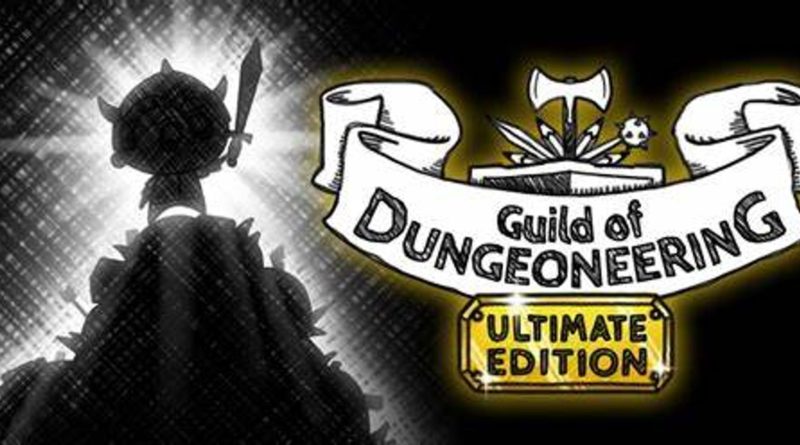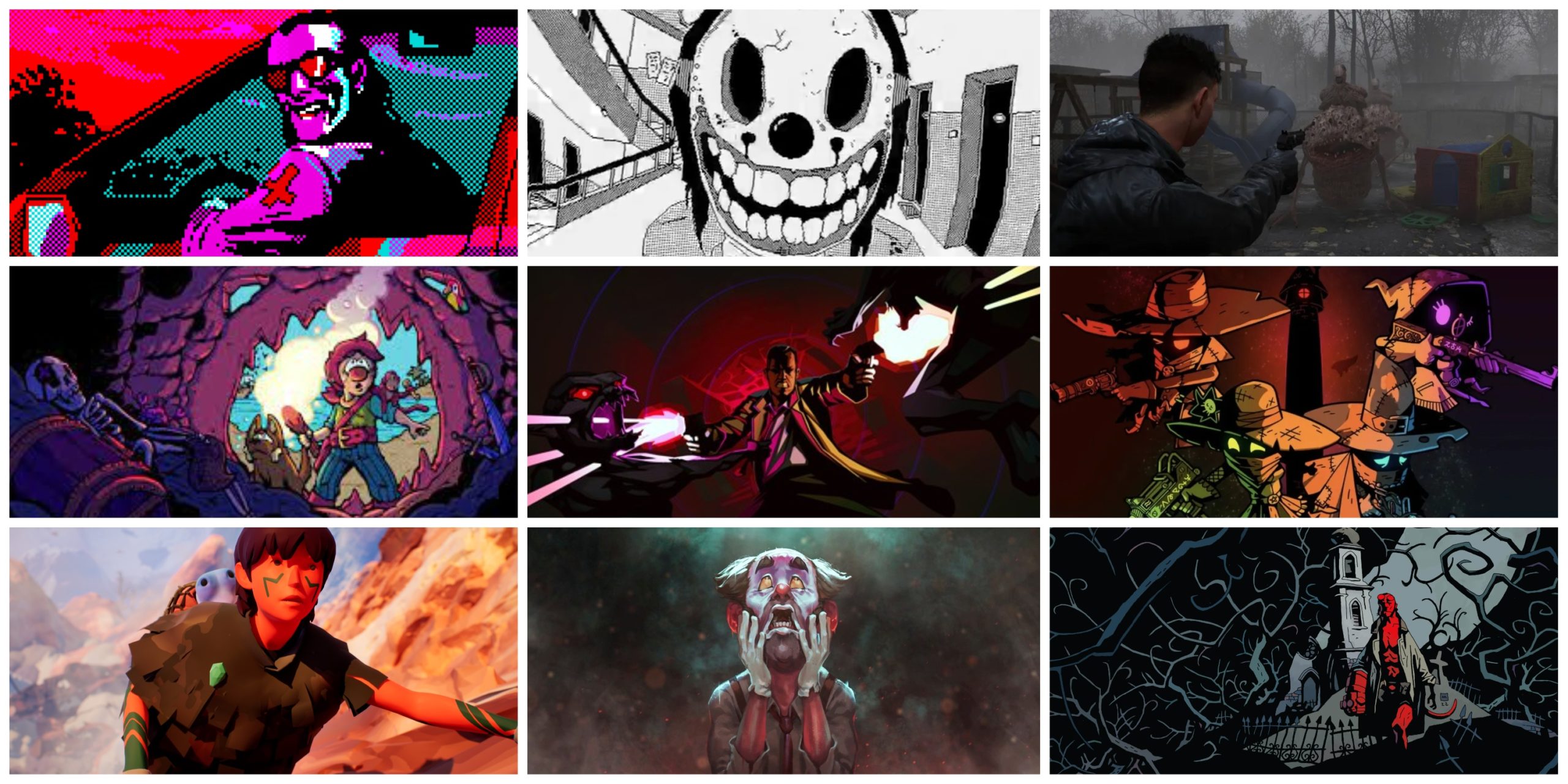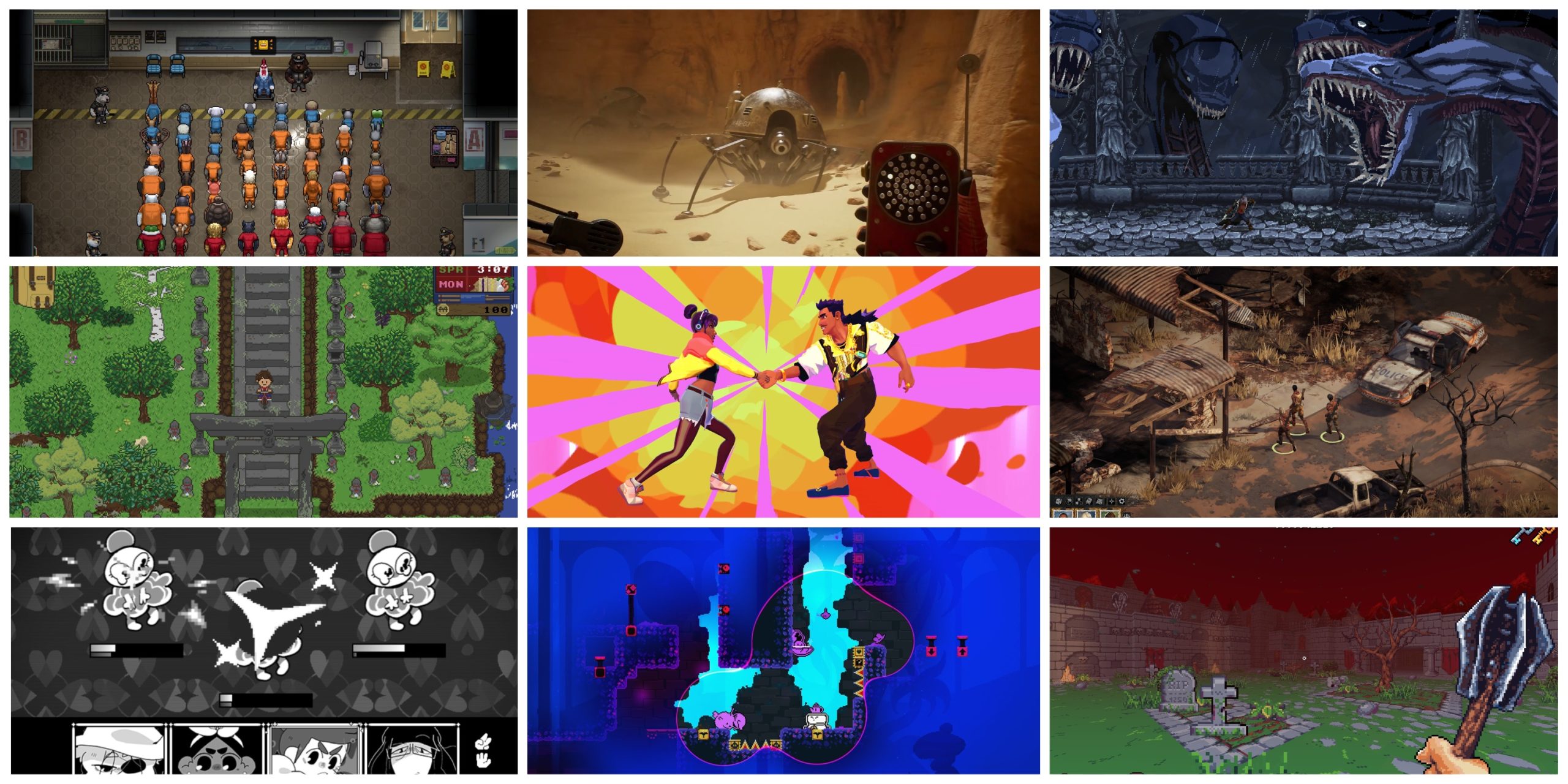Guild of Dungeoneering: Ultimate Edition Review (Switch) – Dungeons, Dungeons and oh, more Dungeons
Playing like a classic D&D or Munchkin inspired board game, does Guild of Dungeoneering: Ultimate Edition deliver enough of a remaster? The Finger Guns Review:
I’ve recently been enjoying my first forays into Switch gaming, what with its on-the-go style and swathe of indie titles. Guild of Dungeoneering: Ultimate Edition was right outside of my normal wheelhouse, to be sure, but it’s a light, fun little game for fans of D&D or board games like Munchkin. I’m getting slightly ahead of myself, let’s start from the top.
Guild of Dungeoneering was first released in 2015 on PC, being met with mostly positive feedback. Ultimate Edition, releasing on Switch a mere 7 years later, is an entirely rebuilt and remastered version of the original release. Not only that, it comes packed with two new content sections, improved customisation options for your tiny dungeoneers, re-balanced game mechanics and new sound effects, animations and writing. Having not played the vanilla version, I’ll be mainly reviewing Ultimate Edition’s offering based on a new player’s perspective. So let’s delve in and see if this is a finished dungeon extravaganza or a half-baked, dead-end leading mess.
Base Camp, Below Ground
Your time in Guild of Dungeoneering: Ultimate Edition will be split between establishing the various rooms of your ever-expanding lair, which equates to about 15%. The other 85% will be consumed in the various pits you’ll venture off to in search of gold and foes to slay. Naturally then, it makes sense to start with the smaller chunk – your home base of dungeoneering operations.
Starting with a single room, you’re able to slowly develop your cavern of miss-mash rooms into a hive for various adorable adventurers to set out from. Purchasing new rooms allows you to bolt them onto the sides of already established rooms, giving you access to new classes of units you can then deploy on the battlefield. There’s no strategy or composition you need to consider, but the pencil drawn and shaded art style gives it a homely feel. You’ll even get an icon of each dungeoneer in their room to help make it feel somewhat alive, even if they don’t actually do anything, like at all.
There are some creative units to acquire, from the Theatre-loving Mime to the Ice Cloister, housing my personal favourite unit: the Ice Cream Monk. As you progress, completing various dungeon levels and conquering powerful boss figures, you’ll gain further access to more creative tactical options and new rooms to outfit your castle under the mud. While it’s simplistic, it has a real charm about it. As you build out your dungeoneer kingdom you’ll even get access to a graveyard to see fallen heroes who you’ve definitely failed by poor planning (and rough RNG…) and a trophy room with trinkets to reminisce on your successes.
I do wish there was a bit more to the home base system, as it’s completely static and lacking much of any interaction. Despite that though, it has a cosy feel to it and helps the sense of progression as you watch it expand with each victory.
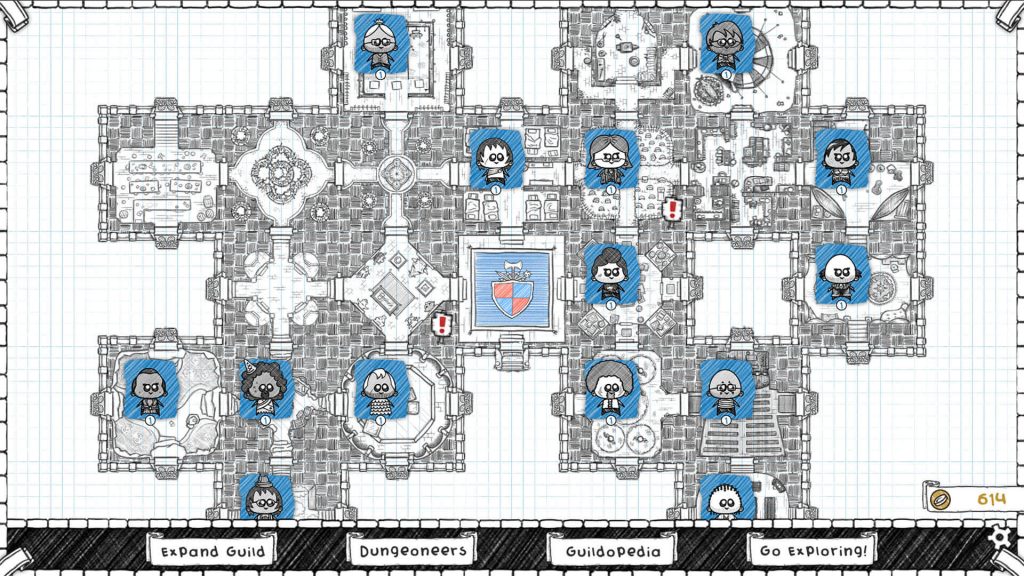
Venture Into The Unknown, That Is, Until It Becomes Known
Once you’re done marvelling at your sprawling, handcrafted metropolis of funny looking icon people, you’ll need to actually go out and, you know, whack some things. Hitting the “Go Exploring” tab takes you to game’s map, where you’ll slowly unveil the clouds over the land, leading to increasingly difficult – yet rewarding – dungeons to subject your hapless dungeoneer disciples to.
The interesting twist with Guild of Dungeoneering however, is that you don’t control your selected character in a level. Well, not directly. Instead, on each turn you’ll be presented with a handful of cards. Blue cards help “draw in” the dungeon, connecting your little person to their objective. Yellow cards offer treasures you can place to be collected, while red cards plonk all manner of enemies where you select them to go. I’m sure you see where this is going.
Our knuckle-headed dungeoneers are easily manipulated, you see. If you place treasure, or an enemy within the dungeon, they’ll change their pathing towards them, always homing in on the highest value area. As such, it’s your job to get them from A to B, either beelining it to take your chances, or cross through routes H, Z and Y to gather everything first. While the first of each dungeon’s 3 levels will usually have an easier task (e.g eliminate 3 of X enemy or reach Y spot), the latter two will normally confront you with a boss encounter you’ll need to overcome, only you’ll be under-levelled.
You start every stage at level 1, meaning if the end boss is level 4, you’re gonna get royally whooped out of the ground faster than you can say this game’s title. Consequently, the trick is to strategically navigate your ice-scoop throwing minion to treasure chests for loot which provide upgrades and boosts, while also plopping easier combat encounters in their way to level them up before taking on the big bad. It’s a really interesting system and one that will initially throw you off as you try to get used to not placing dead ends in strategically important slots (happened far more often than I’m willing to admit) and tactically selecting what routes and enemies your dungeoneer should navigate.
Nothing felt quite as rewarding as pulling off the “perfect” level, complete with slotting enhancement-equipped rooms and a veritable conga line of easier enemies to fell on your way to trouncing the boss. Unfortunately, this structure is the same for every level of every dungeon. Meaning once you’ve done just a handful of them you’ll never need to mix up your strategy all that much. It’s lacking a bit of variety, especially given the new content packs add so many extra levels that follow the same format.

A Card For Every Occasion
Of course, no dungeon is complete without monsters and opponents to best. Good thing that Guild has a pretty massive pool of human, spirit, beast and all manner of other surprise enemies to take on during your expeditions. When you hit the same tile as a red-marked opponent, you’ll be shifted into the combat screen. Once again, the board game inspiration is laid on pretty think as you engage in a dynamic duel of… picking from 1-6+ cards in your hand to play against your enemy.
Each dungeoneer has their own unique base set of cards, usually matched to their archetype. The Bruiser for example, mainly deals in physical damage, shouting “Oi” at the corresponding card being played and can counter physical attacks nicely, but is vulnerable as all sin to magic attacks. As you progress through a dungeon and pick up equipable items from loot, you’ll access new, more powerful cards to compliment their deck, which resets again at the start of each stage. Purchasing more rooms opens up more loot items, meaning more powerful cards to play in combat. It’s all a nice cycle.
In turn, enemies have their own unique decks and tactics, so you’ll have to think on the fly for what best to play, whether it be negating 3 physical hits but trading no damage, or going all out warfare by trying to out DPS them. Later enemies have some cool variants of cards, like stacking the damage you do to them against you next turn, or freezing the rest of your deck for a turn except your one newly flipped card. Your opponent will always draw and move first, meaning if you have equal health and are dealing the same damage to each other, the AI will usually win. This necessitates either levelling your character well for tougher foes, or playing smartly to get an advantage sooner rather than later.
You’ll find your preferred classes pretty quickly (honestly, Ice Cream Scoop dude is a boss) which compliment how you like to play. As you gain new varieties of cards to equip from loot too, you’ll find compositions that are exceptionally powerful. When my Ice Cream boss found cards that dealt damage while simultaneously regenerating my health, stacked on a trait that doubles the effect of regeneration, I became nigh on omnipotent – for that dungeon run.
That’s the nice thing too – because your deck resets to the basic loadout at the start of every stage, you aren’t super over-powered every time. It’s a double-edged sword however, as having to start with the same cards gets boring after a while. So, you either mix different classes (not a fan), or just accept the early tedium in each stage. You’re always at the mercy of RNG too, so don’t be surprised to find a run come to an unceremonious end when you get dealt all the cards you absolutely don’t need just as you’re on 2 health and about to be slapped into the dirt. Sigh.
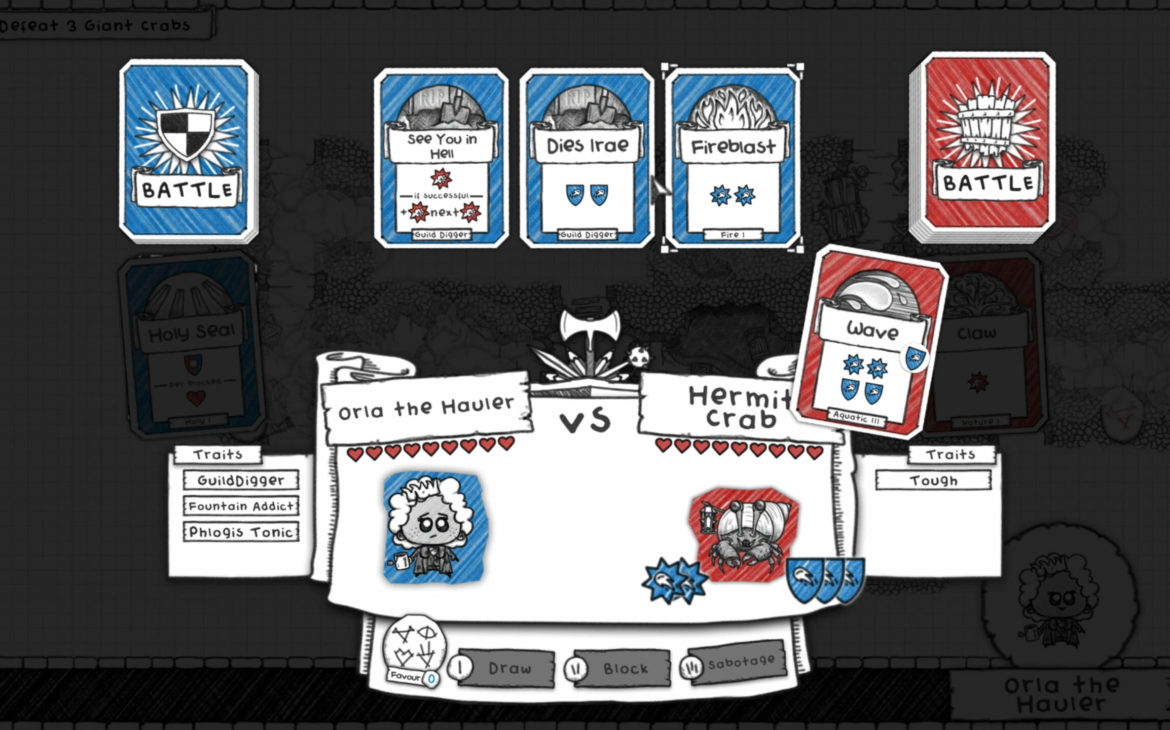
Death Is Not The End
Your brave dungeoneers will need to aware of said slapping dirt prophecy too, as if they are unfortunate enough to suffer this fate, they’ll be buried for good. Fear not, for they will be replaced after a single dungeon run by a new lackey, but their sacrifice will be remembered in the graveyard (with increasingly large gravestones depending on their contributions, which is cool).
Yet despite the untimely deaths and some frustrating RNG deaths, Guild of Dungeoneering has some truly enticing features. The new animations and graphics are tidy additions to the old presentation from what I’ve seen. The wealth of new dungeons, loot, quests and classes adds a significant amount of playing hours to the game. Even the addition of the Guildopedia to see every move and enemy in the game demonstrates how much love has been put into making this package a serious upgrade from its original release.
After a few hours though, the gameplay loop can become a bit too samey, with repetitive dungeon objectives and a card system that’s just lacking that bit of spice to make it truly pop. At times, when a dungeon had a unique set up, like needing to level up ASAP before a chasing boss caught up to me, or I hit that sweet spot of an OP deck to avenge my previous 3 fallen minions-at-arms to a particularly difficult boss, I was pretty entranced in this charming, quaint dungeoneering title. I do wonder if the addition of so much content may have slightly saturated its gameplay somewhat, but this a subjective thought. If you enjoy the card-based gameplay then you’ll have plenty to keep you occupied, which is a good thing. It didn’t quite stick 100% of the time with me, but it definitely will for some.
Plus, this indie game is so creative with its art-style, enemy variety and humorous bosses – the definitely not Frozen’s Elsa: “Generic Non-infringing Cartoon Ice Princess” – that it’s hard not to appreciate the amount of care and craft that’s gone into it. It isn’t the very best of its kind, but it has that same appeal as a nostalgic board game you’ve played dozens of times. It never blows your mind with surprise, but it has an aura of warmness and comfort that you can’t help but love anyway.
Guild of Dungeoneering: Ultimate Edition is a remaster done right. All new animations, effects, bug fixes and nice surprises are stuffed in alongside all of the DLC content to make a complete package. The handcrafted art style is lovely, the card-based exploration and combat mostly satisfying and easy to get into. While it may lack a bit of depth to keep the dungeon raiding at full throttle, it has enough in the tank for a good few hours of monster slaying.

Guild of Dungeoneering: Ultimate Edition is available now on Nintendo Switch (review platform), PC and iOS.
Developer: Gambrinous
Publisher: Gambrinous
Disclaimer: In order to complete this review, we were provided with a promotional copy of the game. For our full review policy, please go here.
If you enjoyed this article or any more of our content, please consider our Patreon.
Make sure to follow Finger Guns on our social channels –Twitter, Facebook, Twitch, Spotify or Apple Podcasts – to keep up to date on our news, reviews and features,
